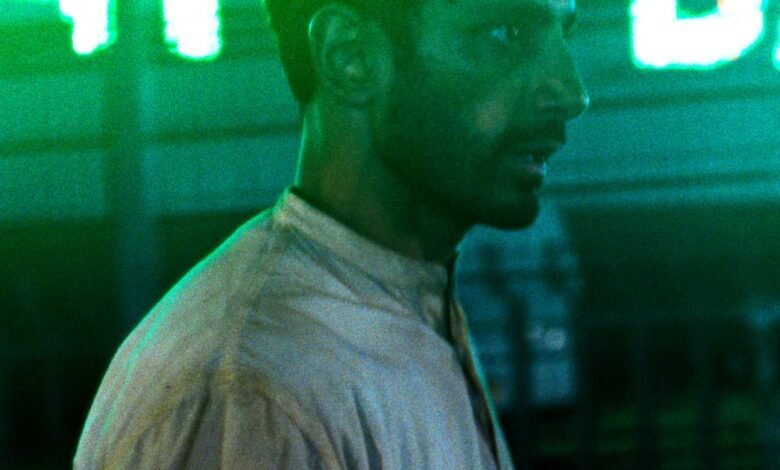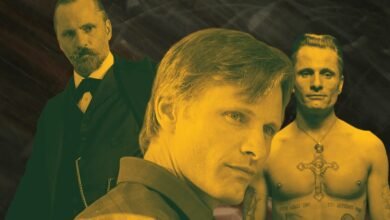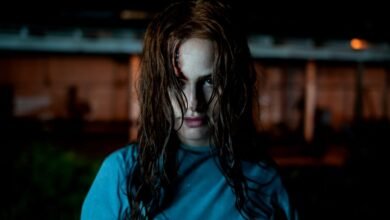

There are shades of Succession in Aneil Karia’s Hamlet: a stylish, uneven adaptation that takes pleasure in entropy and extremity. Set at the estate of a wealthy desi family in present-day London, the film begins by bringing our eponymous prince (Riz Ahmed) face-to-face with his father’s corpse. We see him performing rites, anointing the body with sandalwood paste; the naturalistic handheld camera (DOP Stuart Bentley’s) moves us from the sterile morgue to a ceremony room and the staid performance of a funeral bhajan, then straight into the crematory’s roaring flames for the title credits. This isn’t your grandma’s Hamlet, it seems to argue.
Labouring this further under magenta-yellow club lights, Ahmed’s protagonist takes a big bump of something offered up by Laertes (a characteristically smarmy and despondent Joe Alwyn). At times, the film’s action-fuelled instincts can tend a little try-hard. Speeding down the highway with a death wish, Hamlet delivers his infamous existential monologue while threatening to crash his BMW into a semi-truck driving in the opposite direction.
Get more Little White Lies
The prince’s unravelling is already in motion, catalysed when his magnate father appears to him on a rooftop, telling of his own murder. Spurred on by anger and bewilderment at the suspiciously hasty marriage of his shadowy uncle Claudius (Art Malik) and his widowed mother Gertrude (Sheeba Chaddha), Hamlet lashes out at Polonius (Timothy Spall), soaking the beige-toned minimalism of the family mansion in a vast pool of dark blood.
Karia relies heavily on facial close-ups throughout, anchoring the story in Ahmed’s increasingly erratic expressions of grief as the young heir to Elsinore – the castle ciphered here as a powerful and unpopular (or at least frequently graffiti’d‑about) construction group. This thread proves to be little more than late capitalist window dressing, but the merits of Karia’s adaptation lie within smaller compositional details and moments of genuine flair.
When Gertrude and Claudius marry, for example, a troupe of Indian dancers campily reenact the hypothetical poisoning, made up in kohl and gold body paint. At the top of the scene, Hamlet dons a mirrored headscarf and a smear of fuchsia lip paint. Drunk on loathing, he reaches for the microphone and proceeds to wreak havoc, making dick jokes and causing Ophelia (Morfydd Clark) to burst into tears.
For the most part, costume designer Nirage Mirage opts to clothe the cast in sombre, business casual neutrals. During the wedding scene, Hamlet’s off-white kurta temporarily disappears under a brocaded, ivory-coloured nehru jacket. Laertes smoulders in an ash brown suit, and Ophelia wears a silk lehenga in a muted chartreuse, deep red mehndi dotting her hands and wrists. The film is an undeniably beautiful one, though not quite unique enough to make a case for its adaptation. Certain aspects of the production – such as the casual mix of Shakespearian English and conversational Hindi – feel novel, but ultimately don’t push the envelope in the way more successful ones do. Grand Theft Hamlet comes to mind as an especially inventive variation, but Karia’s film is one of three in the TIFF programme (including Chloé Zhao’s Hamnet and Mamoru Hosoda’s Scarlet) based on the very same play.
Perhaps it is inevitable that its synecdochic question would have changed in recent years, with the text having been put through the industry machine so many times. In any case, the one I found myself asking by its conclusion was: How much Hamlet is enough Hamlet?




